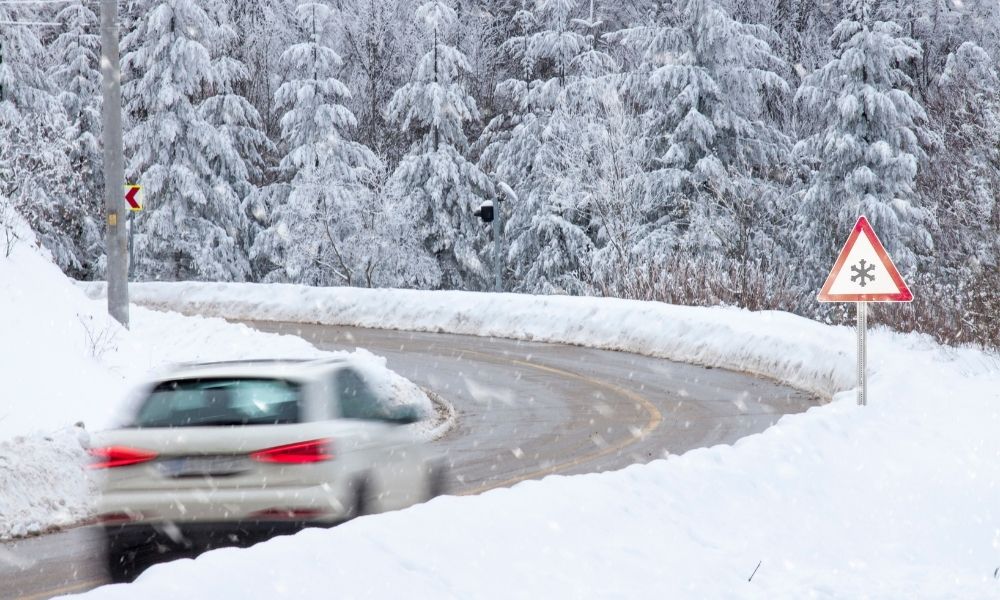Even the most skilled drivers can get into an accident when driving in the snow.
That is, if they are not careful.
This is why, today, we’re going to give you 8 helpful tips for driving in the snow. If you follow these tips, you can keep yourself and your loved ones, as well as everyone around, safe.
So are you ready?
Let’s begin!
8 Tips for Driving in the Snow

Here’s a summary of the tips we will discuss below:
- Prepare Snow Essentials
- Change Into Winter Tires
- Check Road Conditions
- Slow Down
- Leave a Safe Distance
- Never Turn On Cruise Control
- Learn How to Handle a Skid
- Use Anti-Lock Brakes Properly
Let’s get into the details.
1. Prepare Snow Essentials
Even if you’re just going for a quick drive to the grocery store, having the proper essentials for the winter season is important.
Yes, these essentials will help you be prepared for any accident that you might face.
The essentials involve a medical kit, food and water, and some snow tools. It’s best to have all of them in an area where you can access them easily (like the compartment in front).
For the medical kit, we suggest packing bandages, anti-bacterial solutions, gauze, and some pain relievers.
For the food, just try to bring snacks that will help you last a few days. That includes water, too.
And for the snow tools, you should bring an ice scraper, a flashlight, a small shovel, and a pair of gloves.
You can never be too prepared.
2. Change into Winter Tires
Tires serve as your car’s shoes. And with the change of weather, it makes sense that your tires change into the appropriate set.
As the name suggests, winter tires are specifically made for ice, snow, and slippery roads. They reduce the chances of skidding and provide more grip and traction on the road.
So before you set out to drive, make sure that you’ve already changed your tires to winter tires. Best to do it before the winter even arrives.
3. Check Road Conditions
It’s a good idea to check the road for its texture and appearance. Different textures of snow help indicate whether it’s safe to drive over or whether you should avoid it.
Let’s look at some of these textures.
Shiny roads usually mean the snow hasn’t frozen yet. In turn, it is very slippery.
If the road is dark, it’s even more dangerous since it can be deceptive – it mimics the color of the road, therefore, you don’t know if there is ice or not. So as always, be careful when driving over dark roads.
Black ice usually forms in areas where there is less heat to warm up the roads. It is also present during the evenings and early mornings because there is not enough heat from the sun to melt the ice.
It’s a good idea to know all these road conditions so you can be extra careful when driving over them. Or better yet, just try to avoid going on these roads.
4. Slow Down
This may seem obvious, but it’s still worth stressing. When you drive during the winter season always reduce your speed.
When you slow down, you have more control of your car. Also, you lessen the chance of sliding or skidding.
If there’s someone in front of you who has lost control of their car, going at a slow speed will help you avoid crashing into the car.
Slowing down will also afford you the time to change direction if you see an accident in front of you.
5. Leave a Safe Distance
When you’re driving (even if it’s not the winter season), always make sure to keep a safe distance between your car and the car in front of you.
This way, you can have ample space and time to react to whatever it is that is happening in front of you. This might be the difference between a wrecked car and a car that’s been unscathed.
Likewise, it’s best to turn on your headlights to keep your car visible. This will also help other drivers assess how near they are to you.
6. Never Turn On Cruise Control
We’ve talked about slowing down and giving ample space to the car in front. However, this does not mean that you can activate Cruise Control.
Cruise Control is not meant for driving in the snow because it doesn’t react immediately to the changes in traction and road texture. Compare this to when you’re in full control, you’ll be able to assess the braking and speeding more accurately.
So even if you are required to drive slowly and deliberately, turning on Cruise Control is not going to improve your overall drive. It might just lead you to danger.
7. Learn How to Handle a Skid
Say, you end up skidding on the road. This isn’t a pleasant feeling, but just avoid panicking. If you do, it could just get worse.
If your front tires cause a skid, what you can do is lift your foot from the gas. This will eventually slow your car and will bring you back to the right traction.
Don’t jam on the brakes as it might thrust you forward, especially if you’re driving fast.
If your rear tires are the ones skidding, again, don’t step on the brakes. What you should do is steer the wheel in the direction your rear tires are going. For example, if the tires go to the right, steer your wheel to the right, too.
8. Use Anti-Lock Brakes Properly
Newer cars have a new feature called an anti-lock brake system (ABS). The purpose of the ABS is to maximize the braking system under extreme conditions.
For example, you experience a skid and you’re struggling to control your car. The ABS will come in handy as its technology will help you increase the aggressiveness of the braking. In other words, it helps you stop the car faster.
To activate the ABS, just push the brake pedal down for a long time. This will already activate the computers that will put more force on braking.
Conclusion
So there you have it — 8 tips that can help you drive more safely in the snow.
Snow can pose an incredible danger to individuals who aren’t prepared for it. Experts recommend drivers avoid riding out in heavy snow.
However, if it’s unavoidable, keep in mind the snow driving tips that we mentioned here. It will help keep you safe while driving on frosty, icy roads.
Safe driving!
